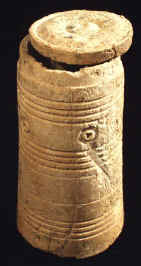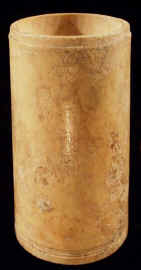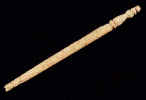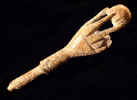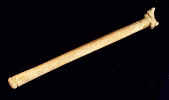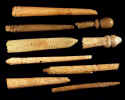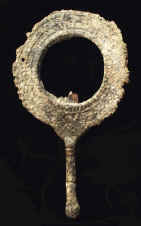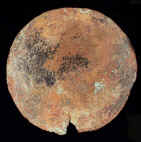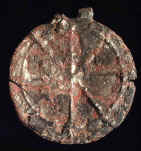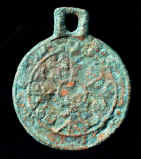1177
ROMAN BONE PYXIS
I century A. D.
Slightly conical bone pyxis with the intended interior sides to receive the bottom of the pyxis; the top cut back to receive the lid. Wider diameter lid with decorative "stepped" moulding. Carved in relief with two diametrically opposed figures from Dionysiac scene: reclining Eros with outstretched wings, looking to his left, his legs are stretched out, he raises his right hand with a cup while resting his left elbow on a pillow. Another Eros with outstretched wings, flying right, holding a wine jar in his extended right hand. Cracked, minor losses of wall at the bottom, central part of the lid is missing. Remains of pink powder substance inside.
H. (with lid) 1.9" (4.7 cm).
$ 2000
1175
ROMAN BONE PYXIS
III-IV century A. D.
Slightly conical bone pyxis with the intended interior sides to receive the bottom of the pyxis; the top cut back. The lid with same diameter and concentric moulding. Bottom with incised concentric lines. Body decorated with bands of four parallel lines with a row of "dot in a circle" in between. Slightly chipped at the edges, otherwise intact.
H. (with lid) 2.5" (6.3 cm).
See similar pyxis: Davidson G.R. Corinth, vol XII, The Minor Objects. Princeton, 1952, p.136, cat. 964.
$ 350
1176
ROMAN BONE PYXIS
III-IV century A. D.
Slightly conical bone pyxis with the intended interior sides to receive the bottom of the pyxis; the top cut back. Bottom with incised concentric lines. Body decorated with bands of three fine parallel lines above the bottom; highly polished. Interior smoothly finished. Intact.
H. 2.4" (6 cm).
See close parallel: Davidson G.R. Corinth, vol XII, The Minor Objects. Princeton, 1952, p.136, cat. 965.
$ 300
1121
ROMAN BONE HAIR PIN
IV-VI century A. D.
Slightly convex triangular plate extended by two long parallel prongs with round cross-sections, their ends flaring. Polished. Intact.
L. 3.7" (9.4 cm).
$ 300
1007
ROMAN LED MIRROR
late II-early III century A.D.
Cast as one piece. Disc-frame with side-handle, decorated entirely with geometric design in relief: beaded outer and inner circumferences, with concentrical circles between. Junction with the handle covered with cross-hatched lines. There is fragment of glass preserved in a slot in the frame. Handle is broken in several places and mended. D. 1.7" (4.3 cm), H. 3" (7.6 cm).
It seems that the presence of the glass indicates a different approach to achieve a highly reflective surface: instead of polishing metal, glass was chosen ( inner face coated with a layer of tin, which was then polished thoroughly). Or perhaps, the impractical size of this mirror and the choice of led allowing to assume its cultic function, in such case reflecting surface could be symbolic.
See similar mirrors: Fremersdorf F. Die Denkmäler Des Römischen Köln. 1984, Köln, cat. 244-246.
$ 250
1009
BRONZE MIRROR
I-II centuries A.D.
Slightly convex thin disk with gilt face side. Several cracks. Original gilding still preserved in places and reflecting images. D. 2.7" (6.9 cm).
$ 100
1005
SARMATIAN BRONZE MIRROR
II-III centuries A.D.
Cast bronze with tin-enrichment of the surface during the course of casting. Flat disk with a pronounced ridge around the perimeter and side handle with an opening for suspension. In the middle there is an encrypted symbol in relief. D. 2" (5 cm), H. 2.4" (6 cm).
According to some written sources, such as Pliny and Ammianus Marcellinus, some tribes, including Sarmatian, were using encrypted signs in tattoos as heraldry to underline social status. Plin, N. H., XXII, 2; Amm. Marc., XXXI, 17. Sarmatian signs contain ideas of right of ownership of the tribe, kin or individual. See: S.V.Drachuk. Pro tsar'ski znaki Bospora Kimmeriyskogo. Arheologiya, XXII, Kiev, 1969. E. I. Solomonik. Sarmatskiye znaki Severnogo Prichernomor'ya, Kiev, 1959.
$ 1000
1012
SARMATIAN BRONZE MIRROR
II-III centuries A.D.
Cast bronze with tin-enrichment of the surface during the course of casting. Flat disk with a pronounced ridge around the perimeter and side handle with an opening for suspension. In the middle there is an encrypted symbol in relief. Fragment missing (ancient loss). D. 2.6" (6.6 cm), H. 2.4" (6.2 cm).
According to some written sources, such as Pliny and Ammianus Marcellinus, some tribes, including Sarmatian, were using encrypted signs in tattoos as heraldry to underline social status. Plin, N. H., XXII, 2; Amm. Marc., XXXI, 17. Sarmatian signs contain ideas of right of ownership of the tribe, kin or individual. See: S.V.Drachuk. Pro tsar'ski znaki Bospora Kimmeriyskogo. Arheologiya, XXII, Kiev, 1969. E. I. Solomonik. Sarmatskiye znaki Severnogo Prichernomor'ya, Kiev, 1959.
$ 300
510
BRONZE MIRROR
III century A.D.
Cast bronze with tin-enrichment of the surface during the course of casting. Flat disk with a ridge along the perimeter and diametrical lines in relief, dividing the disk into eight equal parts. Fragment of suspension loop is missing (ancient loss).
D. 2.4" (6 cm).
See: H.Jänichen. Bildzeichen der kniglichen Hoheit beiden iranishen Völkern. Bonn, 1956.
B.Nadel. Uwagi metodyczne o badaniach nad tzw. zagadkowymi znakami Polnocnego Nadczarnomorza z okresu antycznego. A., XIII, 1962, Warszawa, 1963.
$ 100
1015
BRONZE MIRROR
II century A.D.
Cast bronze flat disk with concentrical circles. With "birds feet" in relief set perpendicular to each other. Side handle has an opening for suspension.
D. 1.7" (4.3 cm). H. 2" (5.1 cm).
See: H.Jänichen. Bildzeichen der kniglichen Hoheit beiden iranishen Völkern. Bonn, 1956, table11,14; B.Nadel. Uwagi metodyczne o badaniach nad tzw. zagadkowymi znakami Polnocnego Nadczarnomorza z okresu antycznego. A., XIII, 1962, Warszawa, 1963, pg. 189, table 11,8.
$ 175
1016
BRONZE MIRROR
II century A.D.
Cast bronze with tin-enrichment of the surface during the course of casting. Flat disk with lines in relief sharing a common center to form concentrical circles and four perpendicular lines with half-oval terminations. Side handle has an opening for suspension.
H. 2.4" (6.1 cm). D. 2" (5 cm).
$ 250
1014
BRONZE MIRROR
II century A.D.
Cast bronze with tin-enrichment of the surface during the course of casting. Flat disk with lines in relief sharing a common center to form concentrical circles, "birds feet" set perpendicular to each other and spirals. Side handle has an opening for suspension.
D. 1.5" (3.7 cm). H. 1.8" (4.6 cm).
See: H.Jänichen. Bildzeichen der kniglichen Hoheit beiden iranishen Völkern. Bonn, 1956, table11,14; B.Nadel. Uwagi metodyczne o badaniach nad tzw. zagadkowymi znakami Polnocnego Nadczarnomorza z okresu antycznego. A., XIII, 1962, Warszawa, 1963, pg. 189, table 11,8.
$ 300


